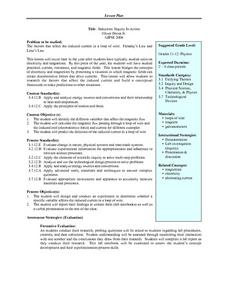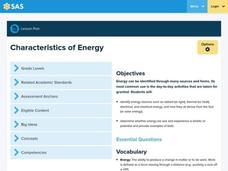Curated OER
Lenz's Law
Students conduct a series of experiments on electromagnetic induction. In this physics lesson, students apply the right hand rule to determine the current direction and electromotive force. They test Lenz's and Faraday's law by observing...
Curated OER
Electricity/Magnetism
Second graders experiment with ballons to see which objects will cling and which objects will not. They use an assortment of objects, paper clips, pennies, button, scraps of paper, or puffed cereal. They make predictions and record results.
LABScI
Circuits Lab: Lightbulbs
Electrons flow from negative to positive, but the general consensus is that current flows from positive to negative. Scholars explore current through construction of circuits in both series and parallel. The focus is on voltage,...
Science Matters
Forms of Energy
The amount of energy Americans use doubles every 20 years. The first instructional activity in a 10-part series teaches scholars about different forms of energy. They rotate through five stations with hands-on activities or experiments...
Curated OER
A Simple Motor
Instructions for building a simple electromagnetic motor are provided for the teacher. Aside from some sketchy background information and a list of content standards to be met, that is about all you will find in this resource. The motor...
Curated OER
The Invention of Faraday Cage
Students demonstrate how Faraday's cage work by building their own electroscope. In this physics lesson, students explain how Faraday's cage work. They cite several applications of this principle in the real world.
Curated OER
What is the Underlying Causality of a Simple Circuit?
Students explore simple circuitry. They compare four models of circuits and explain how each works. Students contrast the cyclic cequential and cyclic simultaneous models using a shower curtain illustration and software simulation.
Curated OER
Reed Switch
Students build simple electromagnetic reed switch motors. For this physics lesson, students explain how it works. They cite real world applications of reed switches and relays.
Curated OER
Maglev Trains
Students explore how Maglev trains work. In this technology lesson, students discuss the pros and cons of Maglev compared to conventional trains. They build a simple Maglev train model.
Curated OER
Riding the Radio Waves
Learners examine the basic concepts of radio waves and magnetic fields. They study how the AM radios are built and demonstrate the concepts of amplitude and frequency.
Curated OER
Induction: Inquiry in Action
Students investigate the factors that affect the induced current in a loop of wire. They discuss Faraday's Law and Lenz's Law. Students identify the different variables that affect the magnetic flux and calculate the magnetic flux...
NOAA
Oceans of Energy
Are the earth's oceans really just giant batteries, waiting for their energy to be harnessed? Middle school mechanical engineers will be shocked by the amazing amount of energy that forms around them after diving into part four of a...
National Nanotechnology Infrastructure Network
Synthesis of Nickel Nanowires
It's all about the scale—they're not just wires, they're nanowires! The second lesson of the series builds on the oxidation-reduction experiment in the first lesson. Scholars synthesize a sample of nanowires using electrolysis. As they...
Curated OER
Orienteering - The Fundamentals
Students investigate the concept of a compass and it has been used in the past and in modern times. They practice using it in the wilderness in order to test its importance in various exploring activities. Each activity is accompanied by...
Curated OER
Electrolytic Titration
Students observe an electrolytic titration using a conductivity tester. For this titration lesson, students observe a solution of acid conducting electricity using the conductivity apparatus. They observe the acid solution being titrated...
Curated OER
Build a Simple Motor?
Students experience how to construct a simple electromagnet based motor. In groups they explore what a component is and construct a circuit that can rotate the orientation of the magnet by turning the switch on and off. Electromagnetic...
Curated OER
WAVES AND PHOTONS
Learners examine the many types of electromagnetic waves, the concept of an EM wave, how James Clerk Maxwell proposed a slight modification of the equations of electricity, Heinrich Hertz and his radio-frequency, wavelengths, and light...
Curated OER
The Physics of Toys
Students explore physics by experimenting with classic toys. In this physical science lesson plan, students utilize gliders, energy balls, bouncing balls, marbles and other toys to explore how they work. Students explore each toy at a...
Curated OER
Characteristics of Energy
Fourth graders view a video and create a KWL to identify energy sources. In this energy sources lesson, 4th graders explore the meaning of energy, kinetic energy, potential energy, thermal energy, radiant energy, and electrical energy....
Curated OER
Exploring Meteorite Mysteries: Building Blocks of Planets
Students simulate the formation of chondrites and asteroids. In this astronomy lesson, students demonstrate accretion using balloons and static electricity. They compare and contrast their models to the actual process of chondrites and...
Curated OER
Transformers
Students examine how a transformer works and its practical applications. In this electricity activity students complete several experiments using transformers and generators.
Curated OER
Construction of an Ammeter and a Voltmeter from a Galvanometer
Students explore series and parallel circuits. In this physics lesson, students construct a simple circuit and measure its maximum current. They construct their own voltmeter and ammeter that operates at a specified range.
Curated OER
Circuit Boards
Pupils explore circuit boards. They determine that a complete circuit is needed to light the bulbs, experiment with the boards to develop strategies for finding where the hidden connections are, and develop strategies that can be used to...
WindWise Education
How Does a Generator Work?
I get a charge out of this. In order to learn how a generator works, groups build and test one in this ninth lesson of the series. The generators are tested at low speed and high speed to determine the watt output and whether they have...

























